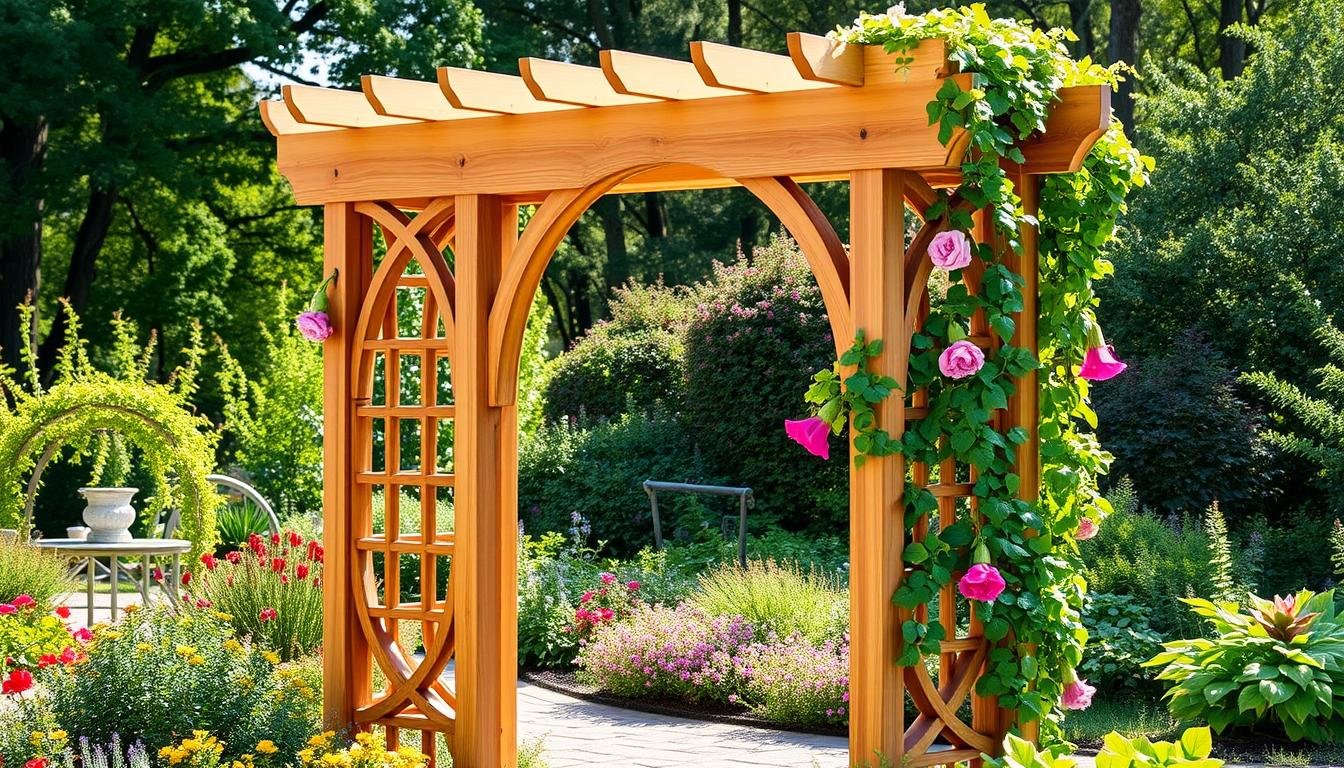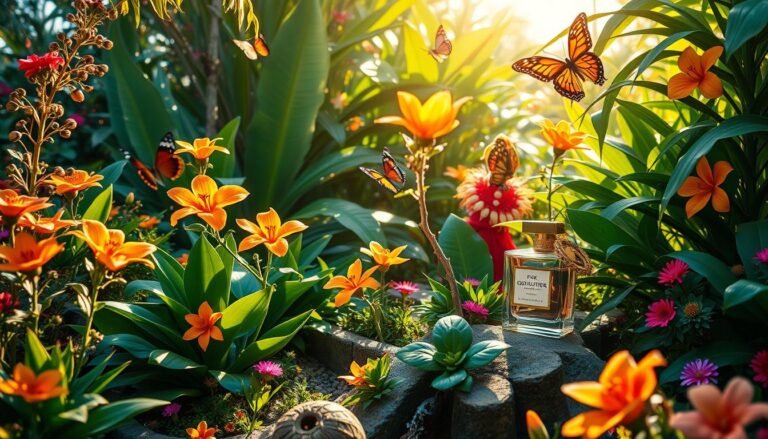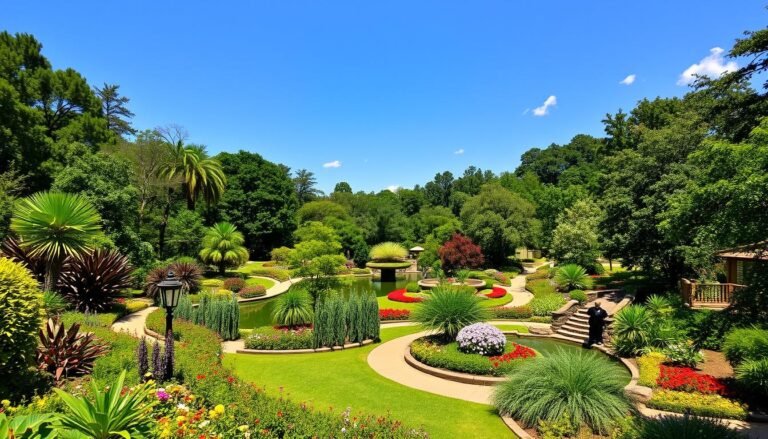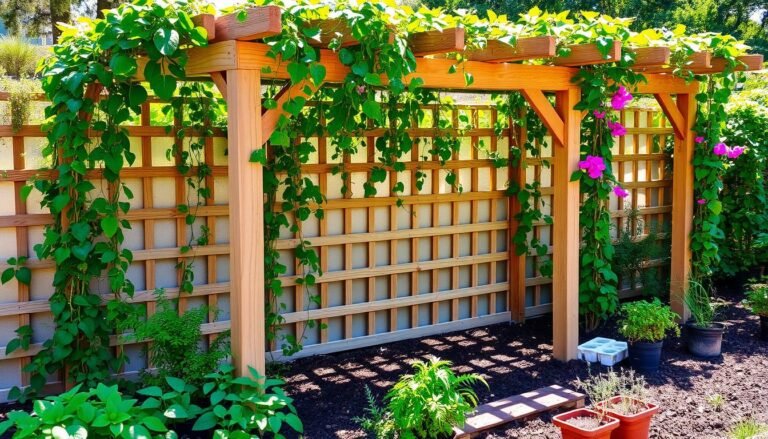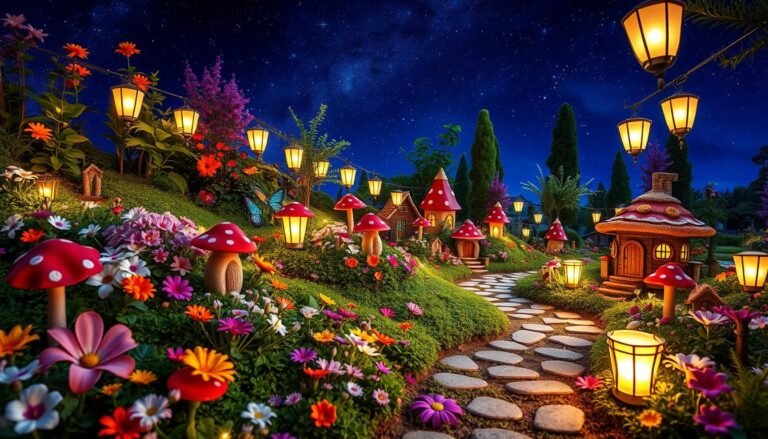Elevate Your Garden with the Best Garden Trellis
Imagine turning your backyard into a magical vertical garden. Garden trellises are key for gardeners wanting to use space well, add drama, and make stunning green walls. They bring life to every corner of your outdoor space.
The best garden trellis is more than just support. It’s a canvas for your climbing plants. Whether you’re growing delicate clematis, fragrant jasmine, or productive fruit vines, the right trellis makes your landscape stunning.
These structures do more than support plants. They create privacy, define garden areas, and add interest to outdoor spaces. You can find them in many styles, from metal with patterns to rustic wood, to fit any landscape.
Key Takeaways
- Garden trellises transform outdoor spaces vertically
- Support multiple plant types including climbers and fruit trees
- Available in diverse materials like metal and wood
- Create privacy and aesthetic boundaries
- Offer affordable landscaping solutions
What is a Garden Trellis?
A garden trellis is a helpful tool that changes how you garden. It lets plants grow up, making your garden look better and use space better.
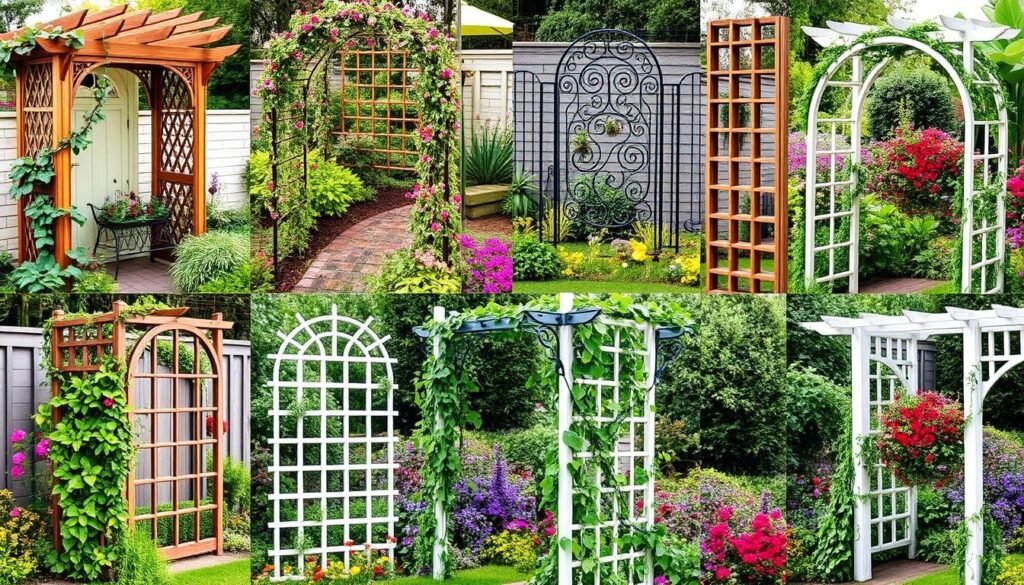
Trellises do more than just hold up plants. They can make your garden up to 50% bigger. This lets more plants grow in small spaces. Trellises also help plants get more sunlight and air, which makes them healthier.
Definition and Purpose
A trellis is a support for climbing plants, made from wood, metal, or plastic. Its main jobs are:
- Supporting climbing plants
- Using space better
- Adding beauty to your garden
- Helping plants grow better
Types of Garden Trellis
There are many types of garden trellises to choose from:
| Trellis Type | Key Characteristics | Best Used For |
|---|---|---|
| Freestanding Trellis | Movable, independent structure | Versatile plant support |
| Wall-Mounted Trellis | Attached to walls or fences | Small spaces, vertical gardening |
| Arch Trellis | Curved or arched design | Decorative garden entrances |
| Lattice Trellis | Criss-cross pattern | Climbing roses, decorative screens |
“A well-designed trellis transforms a simple garden into a living work of art.” – Landscape Design Expert
Looking to support climbing veggies or make a beautiful garden spot? The right trellis can change your outdoor area. Think about what you need in your garden when picking a trellis.
Benefits of Using a Garden Trellis
A garden trellis can change your outdoor space in amazing ways. These structures do more than just hold up plants. They are a big deal for gardens of all sizes.
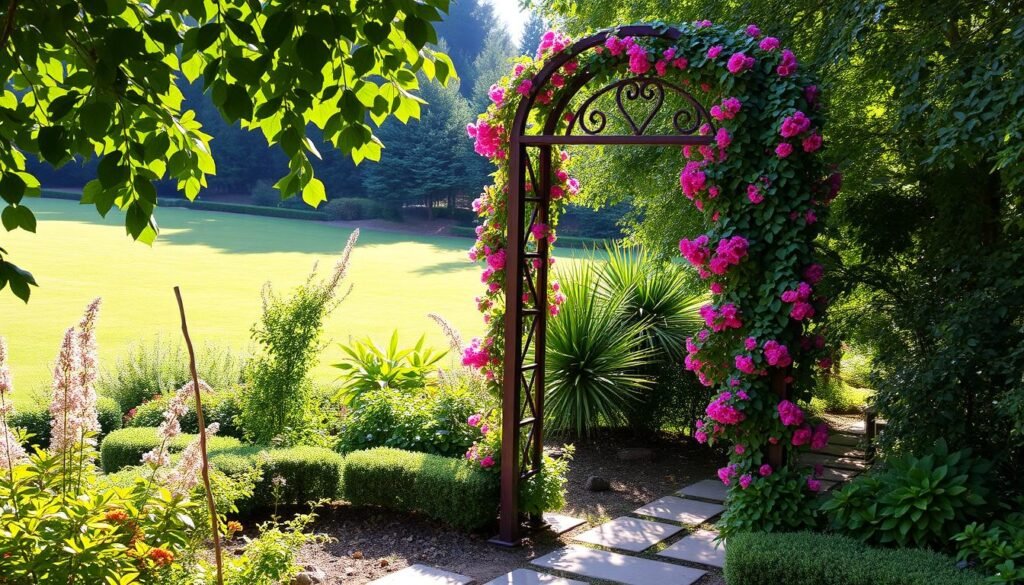
Gardeners are finding out how great garden trellises are for outdoor living. Let’s look at the main benefits that make them essential for garden lovers.
Space Saving Solutions
Urban gardeners face the challenge of small spaces. A decorative garden trellis helps by promoting vertical growth. You can:
- Grow more plants in smaller areas
- Create multi-level garden designs
- Maximize every square foot of your garden
“Vertical gardening with trellises turns space constraints into creative opportunities.” – Garden Design Expert
Enhanced Plant Growth
Garden trellises are not just for looks. They offer vital support for climbing plants, boosting:
- Air circulation around plants
- Sunlight exposure
- Easier plant maintenance
Aesthetic Appeal
But there’s more. A well-designed garden trellis adds beauty to your landscape. These structures can:
- Create visual interest
- Serve as standalone art pieces
- Define garden spaces
Whether you pick wood, metal, or decorative designs, these structures make your outdoor space special.
Popular Materials for Garden Trellises
Choosing the right garden trellis materials can change your gardening experience. The type of trellis you pick affects plant growth, how your garden looks, and how long it lasts. Let’s look at the top garden trellis options for gardeners.
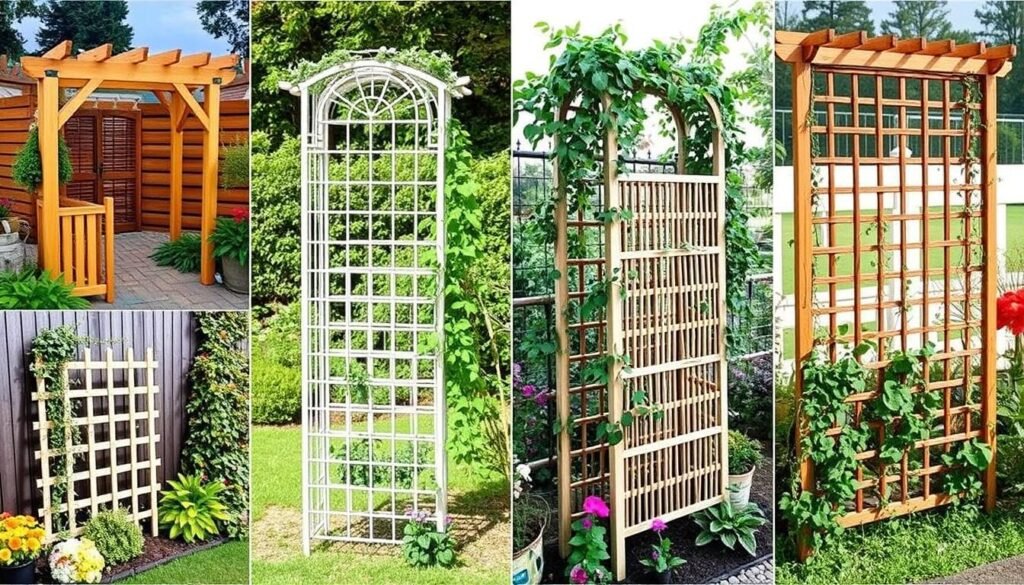
Gardeners have many materials to pick from for vertical support. Each material has its own benefits for different gardening needs.
Wooden Trellises: Natural Elegance
Wooden trellises have a classic, rustic look that fits well with natural gardens. They can be customized and painted to match your garden’s style.
- Affordable and versatile
- Easy to cut and modify
- Natural aesthetic appeal
Metal Trellises: Durability Meets Style
Metal trellises are strong and last a long time. Powder-coated ones resist weather and have a sleek, modern look.
- Extremely durable
- Minimal maintenance required
- Support heavier climbing plants
Plastic Trellises: Lightweight Solutions
Plastic trellises are an affordable, light option for gardeners looking for budget-friendly vertical support.
- Lightweight and easy to install
- Cost-effective
- Ideal for smaller plants
“The right trellis can dramatically enhance your garden’s look without needing more space.” – Gardening Expert
When picking the best garden trellis, think about your plants, climate, and style. Each material has its own benefits for different gardening styles.
| Material | Durability | Cost | Maintenance |
|---|---|---|---|
| Wood | Medium | Low | High |
| Metal | High | Medium | Low |
| Plastic | Low | Low | Low |
How to Choose the Right Garden Trellis
Finding the perfect garden trellis can change your outdoor area and help plants grow well. The right trellis depends on several important factors.
Understanding Your Plant Requirements
Each plant has its own needs for support from a trellis. Think about these key points:
- Vining vegetables like tomatoes need strong support
- Lighter plants such as peas need gentle trellising
- Climbing vegetables grow in unique ways
Sizing Your Trellis Perfectly
Choosing the right size is key for good plant support. Gardeners should look at:
- The size of your garden
- The height your plants will grow
- How much they will grow in the future
“A well-chosen trellis is like a supportive friend for your plants – always there when they need it most.”
Matching Style with Function
Designing your trellis is not just about function. It should also match your garden’s look. Think about using:
- Wooden trellises for a rustic feel
- Metal structures for a modern look
- Vinyl options for easy care
When picking your garden trellis, mix practicality with beauty. This will make your garden both beautiful and thriving.
Installation Tips for Your Garden Trellis
Installing a garden trellis can change your outdoor space. It also helps climbing plants grow. Make sure it’s installed right for it to last long.
Before you start, pick the right spot. It should get enough sunlight and protect your plants.
Preparing Your Garden Bed
Getting your garden bed ready is important. Here’s what to do:
- Clear the area of debris and weeds
- Make sure there’s at least 12 inches between the trellis and the ground
- Check if the soil drains well and is good quality
- Mark where you’ll put the trellis
Securing the Trellis
For a stable trellis, you need to anchor it well. Here are some ways to do it:
- Dig holes deep enough to avoid frost
- Fill the holes with 3/4-inch gravel first (6 inches deep)
- Put fence posts at the right distance
- Use 2×4 inch boards for extra support
Maintenance Tips
To keep your trellis in good shape, follow these tips:
| Maintenance Task | Frequency |
|---|---|
| Check for any damage | Every quarter |
| Remove vine debris | Every season |
| Paint or treat wooden trellises | Every year |
“A well-installed garden trellis is an investment in your garden’s beauty and functionality.” – Gardening Expert
Remember, installing a garden trellis takes time and care. Your climbing plants will appreciate it!
Creative Ways to Use a Trellis in Your Garden
Garden trellises do more than just support plants. They can change your outdoor area by adding new ways to garden, keep things private, and improve looks. Check out the many ways you can use trellises to make your garden better.
With smart garden trellis designs, you can make your garden both useful and beautiful. Here are some cool ideas for using trellises in your garden.
Vertical Gardening Strategies
Vertical gardening turns small spaces into green oases. Trellises let you grow many plants in tight spots, making your garden more productive.
- Create multi-level growing spaces
- Maximize small garden footprints
- Grow vegetables and ornamental plants vertically
Flower and Vegetable Support
Trellises are great for climbing plants, helping them grow tall. Tomatoes, cucumbers, beans, and squash do well with the right trellis.
| Plant Type | Trellis Recommendation | Growth Potencial |
|---|---|---|
| Tomatoes | Sturdy metal trellis | Up to 6 feet vertical growth |
| Climbing Roses | Wooden lattice | Dramatic vertical display |
| Clematis | Lightweight wire trellis | Colorful vertical accent |
Privacy Screen Solutions
Use trellises to make your garden a private spot. Lattice designs can block up to 60% of views while adding beauty.
“A well-placed trellis can turn an ordinary garden into a personal sanctuary.” – Garden Design Expert
Trellises are great for supporting plants and creating privacy. Try different materials, heights, and designs to make your garden unique. Show off your style with your garden.
Seasonal Considerations for Trellis Use
A garden trellis changes with the seasons, needing careful planning and upkeep. Knowing how to care for your trellis in each season helps your plants grow well.
Spring Planting Strategies
Spring is the best time to set up your garden trellis for the growing season. Here are some tips:
- Use weatherproof materials like galvanized steel or treated wood
- Pick the right trellis height for your plants
- Place trellises where they get lots of sunlight
Summer Maintenance Tips
In summer, your trellis needs regular care to keep plants healthy and the structure strong:
- Guide climbing plants gently along the trellis
- Check for damage or loose parts often
- Trim back vines that get too long
Fall Cleanup Suggestions
Getting ready for autumn helps your trellis survive winter:
- Take down annual vines
- Clean and check the trellis
- Put a protective coat on wooden trellises
| Season | Trellis Focus | Key Actions |
|---|---|---|
| Spring | Installation | Material selection, positioning |
| Summer | Maintenance | Plant training, structural checks |
| Fall | Preparation | Cleanup, protection |
“A well-maintained garden trellis is a year-round investment in your landscape’s beauty and productivity.” – Garden Design Expert
Adjusting your care for each season keeps your trellis strong and beautiful all year.
DIY Garden Trellis Ideas
Making your own garden trellis can change your outdoor area. It saves money and adds a personal touch. DIY garden trellis designs let you use vertical space and improve your garden.
Creating garden trellis plans is easy. With some creativity and basic materials, you can make beautiful supports for climbing plants.
Simple Wooden Trellis Projects
Wooden trellises are a classic choice for gardeners. Here are some easy designs:
- A-frame two-sided trellis for heavy fruiting vegetables
- Basic lattice design supporting multiple plant types
- Rustic branch trellis using local wooden materials
Innovative Repurposed Materials
Turn everyday items into unique trellis structures:
- Reclaimed ladder vertical garden support
- Old bicycle wheel circular trellis
- Metal headboard climbing plant framework
Custom Designs
Make your trellis fit your garden needs. Here are tips for custom designs:
- Measure your garden space carefully
- Select materials that complement your landscape
- Choose designs that support specific plant varieties
“Creativity transforms simple materials into functional garden art” – Gardening Enthuasiast
| Material | Cost Effectiveness | Durability |
|---|---|---|
| Wooden Branches | High | Medium |
| Metal Pipes | Medium | High |
| Recycled Ladders | Very High | Medium |
Pro tip: Always ensure your DIY garden trellis is securely anchored and can support the weight of mature climbing plants.
Common Mistakes to Avoid with Garden Trellises
Building a stunning garden trellis needs careful planning and doing. Gardeners often face several issues that can harm their trellis’s look and life. Knowing these common mistakes helps you set up and keep your trellis right.
It’s key to know the challenges when setting up a garden trellis. These challenges can mess up your gardening plans.
Overloading the Trellis Structure
One big mistake gardeners make is putting too much weight on their trellis. Here’s what you should know:
- Heavy climbers like wisteria can grow up to 10 feet in a single season
- Wooden trellises may not support extremely vigorous plants
- Metal trellises typically have a 10-year lifespan when properly maintained
Ignoring Height Restrictions
Local rules and garden design are important when setting up a garden trellis. Think about these points:
- Check neighborhood height restrictions before installation
- Understand your specific garden’s spatial limitations
- Select trellis designs that complement your landscape
Poor Location Choices
Choosing the wrong spot can really hurt plant growth and trellis use. Consider these things:
| Factor | Optimal Conditions | Potential Issues |
|---|---|---|
| Sunlight | 6-8 hours of direct sunlight | Reduced plant growth |
| Soil Conditions | Well-draining, nutrient-rich soil | Poor plant development |
| Wind Exposure | Sheltered areas | Plant damage and stress |
Avoiding these mistakes lets you make a strong and lovely garden trellis. It will help your plants grow and make your outdoor area better.
“A well-planned garden trellis is not just a support structure, but a living piece of garden art.” – Gardening Expert
Trellis Planting Guides
Adding a garden trellis to your garden can change it for the better. It’s a great way to grow plants and make your garden look amazing. More than 70% of gardeners use trellises to improve their outdoor areas.
When picking plants for your trellis, think about both pretty and edible ones. These plants do well in vertical spaces.
Best Plants for Climbing Trellises
- Flowering Plants:
- Clematis
- Climbing roses
- Morning glories
- Passionflower
- Vegetable Climbers:
- Pole beans
- Peas (snow and sugar snap)
- Cucumbers
- Butternut squash
Companion Planting Strategies
There are many ways to use garden trellises. They can help grow different plants together. This makes your garden more productive and beautiful.
| Plant Combination | Benefits | Growth Time |
|---|---|---|
| Pole Beans + Cucumbers | Space optimization | 60-70 days |
| Climbing Peppers + Tomatoes | Nutrient sharing | 60-90 days |
| Bitter Melon + Luffa Gourds | Warm climate adaptation | 100-120 days |
“Vertical gardening can increase garden space utilization by up to 30%, making trellises an essential tool for urban and small-space gardeners.”
It’s important to pick a trellis that fits your plants’ needs. The height, material, and design of the trellis are key. They help your plants grow well and make your garden look great.
Conclusion: Transform Your Garden with a Trellis
Your garden is waiting for a makeover, and a trellis can be the perfect solution. These structures have been around for ages, loved for their beauty and usefulness. They help gardens look amazing and grow better.
Looking for ways to make your garden look better? Trellises are not just for looks. They help plants grow in small spaces, making your garden look stunning. You can pick from metal or wood, finding the perfect match for your garden.
Using a trellis smartly can change your garden game. It can make your plants grow up to 20% more and use space better by almost 50%. Whether you want to grow food, flowers, or need a privacy screen, a good trellis can make a big difference.
Ready to change your garden? Choose a trellis that fits your style and gardening dreams. Start vertical gardening and turn your outdoor area into a lively, productive, and lovely place.

